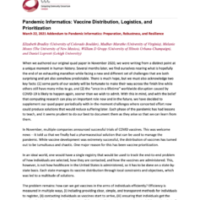Expanding the Pipeline: Gaining Momentum through Research on Diversity in Undergraduate Computing
Five years ago, we wrote in this column about the research our team was initiating on the BRAID (Building Recruiting and Inclusion for Diversity) initiative, a coordinated effort among 15 universities to increase representation among women and Students of Color in their undergraduate computing programs. Over these past five years, the BRAID institutions have indeed made significant strides towards greater diversity. Collectively, while BRAID departments experienced an 87% increase in overall undergraduate computing enrollments, such increases were even larger among women (139%), BLI (Black, Latinx, and Indigenous) students (106%), and BLI women (127%). While there is much more work to be done in order to achieve gender and racial/ethnic parity in computing representation (not to mention fostering more inclusive environments), these figures certainly reflect progress. Further, such progress was not experienced by BRAID institutions alone, as data from the nationwide CRA Taulbee Survey during this same time period also show significant gains in representation among women and underrepresented Students of Color.
Data on representation tells us something about the “what”—Are departments making progress toward achieving greater diversity?—but we are also driven in our research to understand the “why”: What are the conditions that facilitate change? What the conditions that impede it? Since 2014, our team has conducted in-depth research with the BRAID institutions and beyond to investigate these questions that pertain to the “whys” of broadening participation in computing.
In 2020, we established Momentum: Accelerating Equity in Computing and Technology at UCLA as a place to examine a broad range of issues and questions around broadening participation in computing (BPC). The overview below provides a high-level view of the kinds of questions we are addressing in our research at Momentum.
What can we learn about computing-related outcomes for students enrolling in introductory computing courses?
A cornerstone of our research with BRAID institutions has been the administration of baseline and annual follow-up surveys to students taking introductory computing courses. Over 10,000 students have responded to these surveys, enabling us to conduct several studies focusing on specific student populations or desirable outcomes. In published work, we have examined the academic major and minor affiliations of intro computing students, the conditions that promote a sense of belonging among students in computing, as well as the experiences of students who are undecided about their major or are “latecomers” to computing (taking their intro course in their third year or beyond). Papers currently in preparation focus on understanding students’ experiences and pathways beyond the intro course, especially in regards to their persistence in computing majors and their pursuit of graduate degrees or careers in computing fields, while also attending to intersectionality in the computing student experience (e.g., focusing specifically on the experiences of Latina computing students).
We have learned a great deal from our BRAID student survey data about the factors that promote desirable outcomes for computing students. Our research confirms some of what was already known: individual factors, particularly students’ gender and prior computing experience, are influential in shaping student outcomes, even when controlling for a host of other factors. While computing departments cannot make up for structural inequalities that influence women’s and racially/ethnically minoritized students’ access to and experiences around computing prior to college, our research provides new evidence of intermediary factors that can promote positive outcomes for students from underrepresented groups. Across our research, we have found two broad categories of factors that consistently emerged as important for recruiting and retaining students in computing fields, including students’ beliefs around computing and their place in it (e.g., sense of belonging in computing, computing identity, and computing self-efficacy) and networks of support.
Students’ beliefs around their place in computing are central to outcomes such as recruiting undecided students to computing majors and promoting persistence in computing majors, student aspirations to pursue a computing career, and aspirations to pursue graduate school in computing. Our research suggests that gender plays a role in students’ beliefs about their fit in computing, with men coming to CS1 courses with a higher sense of belonging in computing than women, a gender gap that widens by the end of the intro course.
Students’ support systems, particularly students’ relationships and experiences with their peers in computing, are among the most important factors in their sustained interest in computing through college and into graduate school or the workforce. For instance, our research shows that peer support is a positive predictor of students’ sense of belonging at the end of the CS intro course and of initially undecided students’ decision to choose a computing major by the end of CS1. Further, the more time that students spend in computing groups and organizations, the more likely they are to aspire to a computing career or graduate school in computing. Put simply, a great deal of good comes from fostering strong, supportive communities among computing students.
What can we learn from departmental stakeholders about diversity efforts?
An invaluable source of information on the departmental change process is the department chair. Over the past five years, our team has annually conducted interviews with computing department chairs at BRAID institutions. In our first publication stemming from these interviews, we reported on how department chairs in the earliest stages of BRAID made meaning of the lack of diversity in their departments and the various ways in which they approached their BPC efforts. We reported on the degree to which department chairs’ leadership approaches reflected different phases of diversity work, from mobilization to implementation to institutionalization. In a second publication based on these interviews, we shared more about the progress that chairs were making by the second year of BRAID, primarily moving from a state of mobilization to an active state of implementation, with a goal of institutionalizing change. The chairs described this period as a time of building momentum, as they increased their understanding of issues they were facing, fluency in describing their goals to others, and confidence about their ability to effect change. Our team is presently writing up what we are learning from the chairs during the more recent years of BRAID (in particular how they describe and respond to the external dynamics that shape diversity efforts within their department).
We are also engaged in in-depth case studies with several BRAID institutions to understand the ways in which additional stakeholders—students, faculty, and staff—work to advance diversity efforts in the context of booming enrollments in undergraduate computing. This project draws on 55 interviews across four research sites. Findings suggest that departments were largely thinking about broadening participation efforts separately from work to manage growing enrollments. The paper argues that separating out diversity work from core priorities in the department may hinder departments’ ability to sustain BPC efforts into the future. Instead, it is imperative that stakeholders understand how departmental responses to dynamic external forces (e.g., booming enrollments, shifting realities related to COVID-19) impact diversity efforts.
Exploring lingering questions: What can we learn from the CIC initiative?
Despite all that we have learned from the BRAID initiative, we are left with many questions: How do we promote and foster students’ computing identities and computing self-efficacy? How do students’ peer networks support their continued interest in computing? How and why do certain teaching approaches sometimes push students away from computing? We also have unanticipated questions in light of Covid-19, like what can we learn about how students’ variety of living and learning conditions relate to their sense of belonging and interest in computing? Finally, and central to all of these questions, is the issue of how these various dynamics operate for women and racially/ethnically minoritized students.
As such, we are presently embarking on a longitudinal research study of students attending institutions participating in Northeastern University’s Center for Inclusive Computing (CIC) Best Practice Initiative. CIC provides large grants to institutions that graduate over 200 computing students annually in order to scale up “best practices” in BPC. In spring 2021 we are administering baseline surveys to first- and second-year computing students at CIC institutions and plan to conduct follow-up surveys with all respondents in 2023 and 2025. These surveys will build from the BRAID surveys but will probe more deeply on the questions listed above in order to provide additional actionable recommendations to institutions engaged in BPC work.
How can we help the broader BPC community stay on top of emerging research?
Our work at Momentum is also motivated by a desire to connect researchers and practitioners with the broad range of BPC scholarship that exists, but may be difficult to locate. As such, we are developing a comprehensive repository of scholarly articles published in the last 15 years that advance the empirical and theoretical knowledge around BPC in the United States. The database, which will eventually be available and searchable through BPCnet.org, will enable users to access a wide range of published scholarship on BPC, from theories regarding persistent inequities in computing to scholarship on specific BPC interventions.
Finally, given the volume of work mentioned above, and the many other Momentum projects not listed, it should go without saying that all of this is a team effort. Momentum researchers include full-time academics, post-doctoral scholars, graduate students, and external collaborators. This diverse and talented team has produced important scholarship, developed innovative systems for managing quantitative and qualitative data, and has demonstrated an unwavering commitment to ensuring that our work is mindful of—and seeks to redress—the larger systemic forces of racism and sexism that pose barriers for marginalized students in computing and beyond.
About the authors
Linda J. Sax is a Professor of Higher Education and Organizational Change in the UCLA School of Education & Information Studies and Founding Director of Momentum: Accelerating Equity in Computing and Technology. She serves as PI for all Momentum research projects.
Kathleen J. Lehman is an Assistant Academic Researcher in UCLA’s School of Education & Information Studies and Associate Director at Momentum, where she serves as co-PI of the NSF-funded broadening participation literature database, as well as the team’s work with the Center for Inclusive Computing.
Support for Momentum and its research projects has been provided by: AnitaB.org, the National Science Foundation (NSF #1525737, #1936735, #2039800), the Computing Research Association (CRA), the Kapor Center, and Pivotal Ventures.










